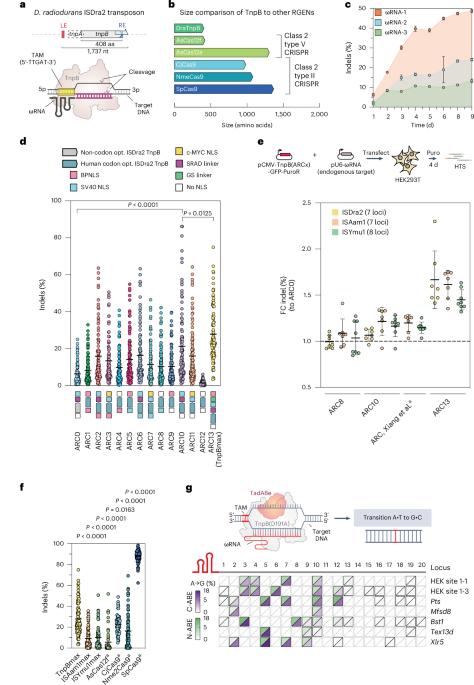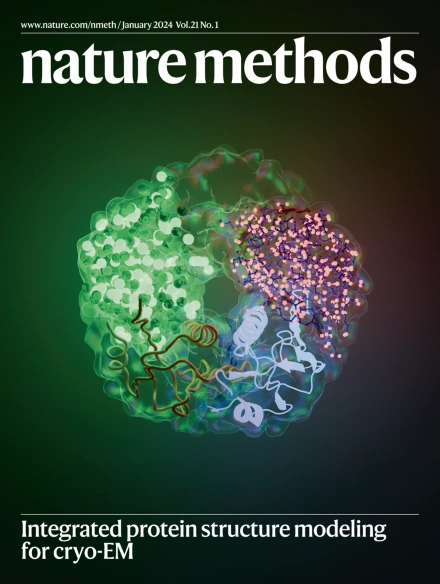Effective genome editing with an enhanced ISDra2 TnpB system and deep learning-predicted ωRNAs
IF 36.1
1区 生物学
Q1 BIOCHEMICAL RESEARCH METHODS
引用次数: 0
Abstract
Transposon (IS200/IS605)-encoded TnpB proteins are predecessors of class 2 type V CRISPR effectors and have emerged as one of the most compact genome editors identified thus far. Here, we optimized the design of Deinococcus radiodurans (ISDra2) TnpB for application in mammalian cells (TnpBmax), leading to an average 4.4-fold improvement in editing. In addition, we developed variants mutated at position K76 that recognize alternative target-adjacent motifs (TAMs), expanding the targeting range of ISDra2 TnpB. We further generated an extensive dataset on TnpBmax editing efficiencies at 10,211 target sites. This enabled us to delineate rules for on-target and off-target editing and to devise a deep learning model, termed TnpB editing efficiency predictor (TEEP; https://www.tnpb.app ), capable of predicting ISDra2 TnpB guiding RNA (ωRNA) activity with high performance (r > 0.8). Employing TEEP, we achieved editing efficiencies up to 75.3% in the murine liver and 65.9% in the murine brain after adeno-associated virus (AAV) vector delivery of TnpBmax. Overall, the set of tools presented in this study facilitates the application of TnpB as an ultracompact programmable endonuclease in research and therapeutics. This work introduces engineered TnpBmax proteins with enhanced efficiency and an expanded targeting range. By leveraging an extensive dataset on editing efficiencies, it also integrates a deep learning model to predict guide RNA activity.

利用增强型 ISDra2 TnpB 系统和深度学习预测的 ωRNAs 进行有效的基因组编辑。
转座子(IS200/IS605)编码的 TnpB 蛋白是 2 类 V 型 CRISPR 效应器的前身,是迄今为止发现的最紧凑的基因组编辑器之一。在这里,我们优化了放射球菌(ISDra2)TnpB 的设计,使其适用于哺乳动物细胞(TnpBmax),从而使编辑能力平均提高了 4.4 倍。此外,我们还开发了在 K76 位发生突变的变体,它们能识别替代的靶邻接基序(TAM),从而扩大了 ISDra2 TnpB 的靶向范围。我们还在 10211 个靶点上生成了 TnpB 最大编辑效率的大量数据集。这使我们能够划定靶上编辑和脱靶编辑的规则,并设计出一种称为 TnpB 编辑效率预测器(TEEP; https://www.tnpb.app )的深度学习模型,该模型能够以高性能(r > 0.8)预测 ISDra2 TnpB 引导 RNA(ωRNA)的活性。利用 TEEP,我们在腺相关病毒(AAV)载体递送 TnpBmax 后,在小鼠肝脏和小鼠大脑中分别实现了高达 75.3% 和 65.9% 的编辑效率。总之,本研究中介绍的这套工具促进了 TnpB 作为超小型可编程内切酶在研究和治疗中的应用。
本文章由计算机程序翻译,如有差异,请以英文原文为准。
求助全文
约1分钟内获得全文
求助全文
来源期刊

Nature Methods
生物-生化研究方法
CiteScore
58.70
自引率
1.70%
发文量
326
审稿时长
1 months
期刊介绍:
Nature Methods is a monthly journal that focuses on publishing innovative methods and substantial enhancements to fundamental life sciences research techniques. Geared towards a diverse, interdisciplinary readership of researchers in academia and industry engaged in laboratory work, the journal offers new tools for research and emphasizes the immediate practical significance of the featured work. It publishes primary research papers and reviews recent technical and methodological advancements, with a particular interest in primary methods papers relevant to the biological and biomedical sciences. This includes methods rooted in chemistry with practical applications for studying biological problems.
 求助内容:
求助内容: 应助结果提醒方式:
应助结果提醒方式:


